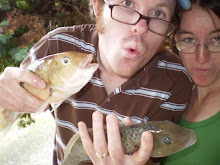Whilst Anna and I were managing the centre over Christmas/New Years, we referred many of our guests to Mohammad for all their snorkeling and dolphin needs. He was very grateful for the business and thus offered us a free dolphin and snorkeling trip (though we still had to pay the marine park fees).
Due to the high cost of snorkeling ($15 US per person per day just for the permit), I had been only once and Anna twice (when she scored a free trip with a workshop she organised). We have, however, found a rock that is separate from the coral reef but still full of life. Particularly cool are the puffer fish and lionfish (my favourite fish as young child). En route to the rock, I have seen turtles three times and Anna once. So we have still been able to get our marine life fix without going broke.
 |
| Rarrrrrr! |
The first part of the trip involved finding the dolphins. Thankfully we had a clever captain who avoided the crowded spots and headed south to find a pod that we could observe by ourselves. Apparently (we found out later) the dolphin watching code of conduct bans jumping into the water when you see them. This is not enforced at all, since the dolphin trips are advertised as swimming with dolphin trips. And swim we did. The dolphins seemed pretty relaxed about our presence, cruising underneath us as we struggled above. I was privileged to watch a mama dolphin help a baby dolphin to the surface for a breath, some 10 meters in front of me. Not only did we get to swim with dolphins, we also got to swim with tiny jellyfish that gave us many sharp stings. Fortunately the itchiness died off after half an hour. After a couple swims we all decided to leave the dolphins to get on with their breakfast.
 |
| These dolphins were apparently cruising around looking for a breakfast of soft corals |
 |
| Notice the jellyfish in left corner. Actual size between 2-5 cm. Squishy to the touch. |
Next stop was the coral garden. We were dropped off at one end and slowly drifted 500m to the other. Coral is amazing. Although much of it wasn’t very colourful, the shapes and patterns were beautiful. Hundreds of species of fish swam, ducked, nibbled, cleaned and hid around us, many with vibrant colours. God had fun with fish.
When we reached the boat again they threw bread out to create swarms of fish. Not very good for the fish (Supa loaf is not that good for humans either!). Such feeding practices and the significant coral damage by higher number of tourists at this end has greatly impacted the biodiversity of fish. Zebra fish were by far the dominant fish species.


We returned to dry land after some 3.5 hours in the water. The birding adventures of the night before (which involved getting up at 2am and ringing birds till dawn) were starting to take their toll, so we had some shut-eye for about 2 minutes. Re-energised with lunch, ‘rested’ and armed with flippers, we swam the 500 meters out to the reef for a second look. The tide was much higher and it was difficult to find the buoy marking the beginning of the reef. We happened across different sections of coral along the way and saw Murray the Moray eel and several stingrays. After 1.5 hours we were all swum out and made our way back to shore. Anna finally saw a green turtle on her way in. A very cool day in the sea.
 |
| "You may call me Murray" |
And whilst we on the topic of seas; for my birthday, Anna promised a sailing trip around Turtle Bay. Ernest and Jean had raved about their trips sailing on Funboats hired from Turtle Bay Beach Club. Yesterday, we skived off out of a meeting to sail the high seas. It’s a great deal. They take the boat to the water, rig it, give you a brief lesson in tacking and send you on your way for an hour. As the winds picked up we flew around the bay, dodging sand banks, moored boats, swimmers, whilst all the time trying to stay upright and not let go of the rope. A great birthday present!
















































